On-Site Water and Wind Erosion Experiments Reveal Relative Impact on Total Soil Erosion
Abstract
1. Introduction
- All tested soil surfaces produce soil erosion due to the action of wind and rain.
- The relative impact of soil erosion agent differs corresponding to site characteristics.
2. Materials and Methods
2.1. Locations and Surface Characteristics
2.1.1. Mediterranean Fallow
2.1.2. Trampling (Goats)
Management and Vulnerability
2.1.3. Mediterranean Orchard
Management and Vulnerability
2.1.4. Wheat Field
Management and Vulnerability
2.1.5. Vineyard
Management and Vulnerability
2.1.6. Sand Substrate
Management and Vulnerability
2.2. Experimental Procedure
2.3. Statistical Analysis
3. Results
4. Discussion
4.1. Mediterranean Fallow
4.2. Trampling or Tillage Impact
4.3. Mediterranean Orchard
4.4. Wheat Field
4.5. Vineyard
4.6. Sand Substrate
4.6.1. Percentages of Erosion
4.6.2. Factors Influencing Erosion Rates on All Sites
5. Conclusions
Author Contributions
Funding
Acknowledgments
Conflicts of Interest
References
- Mann, C.; Garcia-Martin, M.; Raymond, C.M.; Shaw, B.J.; Plieninger, T. The potential for integrated landscape management to fulfil Europe’s commitments to the Sustainable Development Goals. Landsc. Urban. Plan. 2018, 177, 75–82. [Google Scholar] [CrossRef]
- Montanarella, L.; Pennock, D.J.; McKenzie, N.; Badraoui, M.; Chude, V.; Baptista, I.; Mamo, T.; Yemefack, M.; Singh Aulakh, M.; Yagi, K.; et al. World’s soils are under threat. Soil 2016, 2, 79–82. [Google Scholar] [CrossRef]
- Goudie, A.S. Desert dust and human health disorders. Environ. Int. 2014, 63, 101–113. [Google Scholar] [CrossRef] [PubMed]
- Duniway, M.C.; Pfennigwerth, A.; Fick, S.; Nauman, T.; Belnap, J.; Barger, N. Wind erosion and dust from US drylands: A review of causes, consequences, and solutions in a changing world. Ecosphere 2019, 10, e02650. [Google Scholar] [CrossRef]
- Baumgart, P.; Eltner, A.; Domula, A.R.; Barkleit, A.; Faust, D. Scale dependent soil erosion dynamics in a fragile loess landscape. Z. Für Geomorphol. 2017, 61, 191–206. [Google Scholar] [CrossRef]
- Nadal-Romero, E.; Martínez-Murillo, J.F.; Vanmaercke, M.; Poesen, J. Scale-dependency of sediment yield from badland areas in Mediterranean environments. Prog. Phys. Geogr. Earth Environ. 2011, 35, 297–332. [Google Scholar] [CrossRef]
- Borrelli, P.; Robinson, D.A.; Fleischer, L.R.; Lugato, E.; Ballabio, C.; Alewell, C.; Meusburger, K.; Modugno, S.; Schütt, B.; Ferro, V.; et al. An assessment of the global impact of 21st century land use change on soil erosion. Nat. Commun. 2017, 8, 1–13. [Google Scholar] [CrossRef]
- Borrelli, P.; Lugato, E.; Montanarella, L.; Panagos, P. A New Assessment of Soil Loss Due to Wind Erosion in European Agricultural Soils Using a Quantitative Spatially Distributed Modelling Approach. Land Degrad. Dev. 2017, 28, 335–344. [Google Scholar] [CrossRef]
- Oost, K.V.; Quine, T.A.; Govers, G.; Gryze, S.D.; Six, J.; Harden, J.W.; Ritchie, J.C.; McCarty, G.W.; Heckrath, G.; Kosmas, C.; et al. The Impact of Agricultural Soil Erosion on the Global Carbon Cycle. Science 2007, 318, 626–629. [Google Scholar] [CrossRef]
- Panagos, P.; Borrelli, P.; Poesen, J.; Ballabio, C.; Lugato, E.; Meusburger, K.; Montanarella, L.; Alewell, C. The new assessment of soil loss by water erosion in Europe. Environ. Sci. Policy 2015, 54, 438–447. [Google Scholar] [CrossRef]
- Visser, S.M.; Sterk, G.; Ribolzi, O. Techniques for simultaneous quantification of wind and water erosion in semi-arid regions. J. Arid Environ. 2004, 59, 699–717. [Google Scholar] [CrossRef]
- Funk, R.; Frielinghaus, M. Winderosion. In Handbuch der Bodenkunde; Blume, H.P., Ed.; Wiley: Berlin, Germany, 1998; pp. 1–22. [Google Scholar]
- Hoffman, O.; Yizhaq, H.; Boeken, B.R. Small-scale effects of annual and woody vegetation on sediment displacement under field conditions. Catena 2013, 109, 157–163. [Google Scholar] [CrossRef]
- Beniston, M.; Stephenson, D.B.; Christensen, O.B.; Ferro, C.A.T.; Frei, C.; Goyette, S.; Halsnaes, K.; Holt, T.; Jylhä, K.; Koffi, B.; et al. Future extreme events in European climate: An exploration of regional climate model projections. Clim. Chang. 2007, 81, 71–95. [Google Scholar] [CrossRef]
- Guglielmi, G. Hurricanes slow their roll around the world. Nature 2018, 558, 15–16. [Google Scholar] [CrossRef]
- Intergovernmental Panel on Climate Change (IPCC). AR5 Synthesis Report: Climate Change 2014; IPCC: Geneva, Switzerland, 2014. [Google Scholar]
- Chepil, W.; Woodruff, N. The physics of wind erosion and its control. Adv. Agron. 1963, 15, 211. [Google Scholar]
- Ravi, S.; D’Odorico, P.; Breshears, D.; Field, J.; Goudie, A.; Huxman, T.; Li, J.; Okin, G.; Swap, R.; Thomas, A.; et al. Aeolian processes and the biosphere. Rev. Geophys. 2011, 49, Rg3001. [Google Scholar] [CrossRef]
- Chepil, W.S. Conversion of Relative Field Erodibility to Annual Soil Loss by Wind. Soil Sci. Soc. Am. J. 1960, 24, 143–145. [Google Scholar] [CrossRef]
- Katra, I.; Gross, A.; Swet, N.; Tanner, S.; Krasnov, H.; Angert, A. Substantial dust loss of bioavailable phosphorus from agricultural soils. Sci. Rep. 2016, 6, 24736. [Google Scholar] [CrossRef]
- Buschiazzo, D.; Funk, R. Wind Erosion of Agricultural Soils and the Carbon Cycle. In Soil Carbon: Science, Management, and Policy for Multiple Benefits; CABI: Wallingford, UK, 2014. [Google Scholar]
- Intergovernmental Panel on Climate Change IPCC. IPCC Special Report on Climate Change, Desertification, LandDegradation, Sustainable Land Management, Food Security, and Greenhouse Gas Fluxes in Terrestrial Ecosystems; IPCC: Geneva, Switzerland, 2019; p. 43. [Google Scholar]
- García-Ruiz, J.M.; Beguería, S.; Nadal-Romero, E.; González-Hidalgo, J.C.; Lana-Renault, N.; Sanjuán, Y. A meta-analysis of soil erosion rates across the world. Geomorphology 2015, 239, 160–173. [Google Scholar] [CrossRef]
- Savat, J.; De Ploey, J. Sheetwash and rill development by surface flow. In Badland Geomorphology and Piping; Bryan, R.B., Yair, A., Eds.; Geobooks: Norwich, UK, 1982; pp. 113–126. [Google Scholar]
- Keesstra, S.; Mol, G.; De Leeuw, J.; Okx, J.; Molenaar, C.; De Cleen, M.; Visser, S. Soil-Related Sustainable Development Goals: Four Concepts to Make Land Degradation Neutrality and Restoration Work. Land 2018, 7, 133. [Google Scholar] [CrossRef]
- Ravi, S.; Breshears, D.D.; Huxman, T.E.; D’Odorico, P. Land degradation in drylands: Interactions among hydrologic–aeolian erosion and vegetation dynamics. Geomorphology 2010, 116, 236–245. [Google Scholar] [CrossRef]
- Bullard, J.E.; Livingstone, I. Interactions between Aeolian and Fluvial Systems in Dryland Environments. Area 2002, 34, 8–16. [Google Scholar] [CrossRef]
- Siegmund, N.; Funk, R.; Koszinsky, S.; Buschiazzo, D.E.; Sommer, M. Effects of low-scale landscape structures on aeolian transport processes on arable land. Aeolian Res. 2018, 32, 181–191. [Google Scholar] [CrossRef]
- Ho, T.D.; Valance, A.; Dupont, P.; Ould El Moctar, A. Aeolian sand transport: Length and height distributions of saltation trajectories. Aeolian Res. 2014, 12, 65–74. [Google Scholar] [CrossRef]
- Iversen, J.D.; Rasmussen, K.R. The effect of wind speed and bed slope on sand transport. Sedimentology 1999, 46, 723–731. [Google Scholar] [CrossRef]
- Shao, Y.; Lu, H. A simple expression for wind erosion threshold friction velocity. J. Geophys. Res. 2000, 105, 22437–22443. [Google Scholar] [CrossRef]
- Kaiser, A.; Neugirg, F.; Schindewolf, M.; Haas, F.; Schmidt, J. Simulation of rainfall effects on sediment transport on steep slopes in an Alpine catchment. In Sediment Dynamics from the Summit to the Sea; IAHS-AISH publication/IAHS Press: New Orleans, LA, USA, 2015; Volume 367, pp. 43–50. [Google Scholar]
- Sachs, E.; Sarah, P. Effect of Raindrop Temperatures on Soil Runoff and Erosion in Dry and Wet Soils. A Laboratory Experiment. Land Degrad. Dev. 2017, 28, 1549–1556. [Google Scholar] [CrossRef]
- De Lima, J.; Isidoro, J.; De Lima, I.; Singh, V. Longitudinal Hillslope Shape Effects on Runoff and Sediment Loss: Laboratory Flume Experiments. J. Environ. Eng. 2018, 144, 04017097. [Google Scholar] [CrossRef]
- Iserloh, T.; Wirtz, S.; Seeger, M.; Marzolff, I.; Ries, J. Erosion processes on different relief units: The relationship of form and process. Cuad. Investig. Geogr. 2017, 43, 171–187. [Google Scholar] [CrossRef]
- Dunne, T.; Malmon, D.V.; Mudd, S.M. A rain splash transport equation assimilating field and laboratory measurements. J. Geophys. Res. Earth Surf. 2010, 115, F01001. [Google Scholar] [CrossRef]
- Furbish, D.J.; Hamner, K.K.; Schmeeckle, M.; Borosund, M.N.; Mudd, S.M. Rain splash of dry sand revealed by high-speed imaging and sticky paper splash targets. J. Geophys. Res. 2007, 112, F01001. [Google Scholar] [CrossRef]
- Cornelis, W.M.; Oltenfreiter, G.; Gabriels, D.; Hartmann, R. Splash-saltation of sand due to wind-driven rain: Vertical deposition flux and sediment transport rate. Soil Sci. Soc. Am. J. 2004, 68, 32–40. [Google Scholar] [CrossRef]
- De Lima, J.L.M.P.; van Dijk, P.M.; Spaan, W.P. Splash-saltation transport under wind-driven rain. Soil Technol. 1992, 5, 151–166. [Google Scholar] [CrossRef]
- Marzen, M.; Iserloh, T.; de Lima, J.L.M.P.; Ries, J.B. The effect of rain, wind-driven rain and wind on particle transport under controlled laboratory conditions. Catena 2016, 145, 47–55. [Google Scholar] [CrossRef]
- Cantón, Y.; Solé-Benet, A.; de Vente, J.; Boix-Fayos, C.; Calvo-Cases, A.; Asensio, C.; Puigdefábregas, J. A review of runoff generation and soil erosion across scales in semiarid south-eastern Spain. J. Arid Environ. 2011, 75, 1254–1261. [Google Scholar] [CrossRef]
- Poesen, J. Soil erosion in the Anthropocene: Research needs: Soil erosion in the Anthropocene. Earth Surf. Process. Landf. 2018, 43, 64–84. [Google Scholar] [CrossRef]
- Corella, J.P.; Valero-Garcés, B.L.; Serrano, S.M.V.; Brauer, A.; Benito, G. Three millennia of heavy rainfalls in Western Mediterranean: Frequency, seasonality and atmospheric drivers. Sci. Rep. 2016, 6, 38206. [Google Scholar] [CrossRef] [PubMed]
- Diodato, N.; Bellocchi, G. Landscape Scales of Erosive Storm Hazard across the Mediterranean Region. In Storminess and Environmental Change; Diodato, N., Bellocchi, G., Eds.; Advances in Natural and Technological Hazards Research; Springer: Dordrecht, The Netherlands, 2014; pp. 101–116. ISBN 978-94-007-7947-1. [Google Scholar]
- Marzolff, I.; Ries, J.B.; Poesen, J. Short-term versus medium-term monitoring for detecting gully-erosion variability in a Mediterranean environment. Earth Surf. Process. Landf. 2011, 36, 1604–1623. [Google Scholar] [CrossRef]
- Seeger, M. Uncertainty of factors determining runoff and erosion processes as quantified by rainfall simulations. Catena 2007, 71, 56–67. [Google Scholar] [CrossRef]
- Wirtz, S.; Iserloh, T.; Rock, G.; Hansen, R.; Marzen, M.; Seeger, M.; Betz, S.; Remke, A.; Wengel, R.; Butzen, V.; et al. Soil Erosion on Abandoned Land in Andalusia: A Comparison of Interrill- and Rill Erosion Rates. ISRN Soil Sci. 2012, 2012, 1–16. [Google Scholar] [CrossRef]
- Ries, J.B.; Marzen, M.; Iserloh, T.; Fister, W. Soil erosion in Mediterranean landscapes—Experimental investigation on crusted surfaces by means of the Portable Wind and Rainfall Simulator. J. Arid Environ. 2014, 100–101, 42–51. [Google Scholar] [CrossRef]
- Singer, M.; Shainberg, I. Mineral soil surface crusts and wind and water erosion. Earth Surf. Process. Landf. 2004, 29, 1065–1075. [Google Scholar] [CrossRef]
- Ries, J.B.; Hirt, U. Permanence of soil surface crusts on abandoned farmland in the Central Ebro Basin/Spain. Catena 2008, 72, 282–296. [Google Scholar] [CrossRef]
- Zobeck, T.M. Abrasion of Crusted Soils: Influence of Abrader Flux and Soil Properties. Soil Sci. Soc. Am. J. 1991, 55, 1091–1097. [Google Scholar] [CrossRef]
- Ries, J.B. Methodologies for soil erosion and land degradation assessment in mediterranean-type ecosystems. Land Degrad. Dev. 2010, 21, 171–187. [Google Scholar] [CrossRef]
- Ries, J.B. Landnutzungswandel und Landdegradation in Spanien—Eine Einführung. In Landnutzungswandel und Landdegradation in Spanien; Marzolff, I., Ries, J.B., De La Riva, J., Seeger, M., Eds.; Universidad de Zaragoza: Zaragoza, Spain, 2003; pp. 11–31. [Google Scholar]
- Ries, J.B.; Andres, K.; Wirtz, S.; Tumbrink, J.; Wilms, T.; Peter, K.D.; Burczyk, M.; Butzen, V.; Seeger, M. Sheep and goat erosion—Experimental geomorphology as an approach for the quantification of underestimated processes. Z. Für Geomorphol. Suppl. Issues 2014, 58, 23–45. [Google Scholar] [CrossRef]
- Giorgi, F. Climate change hot-spots. Geophys. Res. Lett. 2006, 33, L08707. [Google Scholar] [CrossRef]
- Nissen, K.M.; Leckebusch, G.C.; Pinto, J.G.; Ulbrich, U. Mediterranean cyclones and windstorms in a changing climate. Reg. Environ. Chang. 2014, 14, 1873–1890. [Google Scholar] [CrossRef]
- González-Alemán, J.J.; Pascale, S.; Gutierrez-Fernandez, J.; Murakami, H.; Gaertner, M.A.; Vecchi, G.A. Potential Increase in Hazard From Mediterranean Hurricane Activity With Global Warming. Geophys. Res. Lett. 2019, 46, 1754–1764. [Google Scholar] [CrossRef]
- Morgan, R.P.C. Soil Erosion and Conservation, 3rd ed.; Wiley-Blackwell: Oxford, UK, 2005. [Google Scholar]
- Casalí, J.; López, J.J.; Giráldez, J.V. Ephemeral gully erosion in southern Navarra (Spain). Catena 1999, 36, 65–84. [Google Scholar] [CrossRef]
- Merchán, D.; Luquin, E.; Hernández-García, I.; Campo-Bescós, M.A.; Giménez, R.; Casalí, J.; Del Valle de Lersundi, J. Dissolved solids and suspended sediment dynamics from five small agricultural watersheds in Navarre, Spain: A 10-year study. Catena 2019, 173, 114–130. [Google Scholar] [CrossRef]
- Casalí, J.; Gastesi, R.; Álvarez-Mozos, J.; De Santisteban, L.M.; de Lersundi, J.D.V.; Giménez, R.; Larrañaga, A.; Goñi, M.; Agirre, U.; Campo, M.A.; et al. Runoff, erosion, and water quality of agricultural watersheds in central Navarre (Spain). Agric. Water Manag. 2008, 95, 1111–1128. [Google Scholar] [CrossRef]
- Rodrigo Comino, J.; Iserloh, T.; Lassu, T.; Cerdà, A.; Keestra, S.D.; Prosdocimi, M.; Brings, C.; Marzen, M.; Ramos, M.C.; Senciales, J.M.; et al. Quantitative comparison of initial soil erosion processes and runoff generation in Spanish and German vineyards. Sci. Total Environ. 2016, 565, 1165–1174. [Google Scholar] [CrossRef] [PubMed]
- Rodrigo Comino, J.; Senciales, J.M.; Ramos, M.C.; Martínez-Casasnovas, J.A.; Lasanta, T.; Brevik, E.C.; Ries, J.B.; Ruiz Sinoga, J.D. Understanding soil erosion processes in Mediterranean sloping vineyards (Montes de Málaga, Spain). Geoderma 2017, 296, 47–59. [Google Scholar] [CrossRef]
- Rodrigo-Comino, J.; Wirtz, S.; Brevik, E.C.; Ruiz-Sinoga, J.D.; Ries, J.B. Assessment of agri-spillways as a soil erosion protection measure in Mediterranean sloping vineyards. J. Mt. Sci. 2017, 14, 1009–1022. [Google Scholar] [CrossRef]
- Iserloh, T.; Fister, W.; Marzen, M.; Seeger, M.; Kuhn, N.J.; Ries, J.B. The role of wind-driven rain for soil erosion – an experimental approach. Z. Für Geomorphol. Suppl. Issues 2013, 57, 193–201. [Google Scholar] [CrossRef]
- Enright, N.; McLean, R.F.; Dodson, J. Late Holocene development of two wetlands in the Te Paki region, far northern New Zealand. J. R. Soc. N. Z. 1988, 18, 369–382. [Google Scholar] [CrossRef]
- Fister, W.; Iserloh, T.; Ries, J.B.; Schmidt, R.-G. A portable wind and rainfall simulator for in situ soil erosion measurements. Catena 2012, 91, 72–84. [Google Scholar] [CrossRef]
- Fister, W.; Iserloh, T.; Ries, J.B.; Schmidt, R.G. Comparison of rainfall characteristics of a small portable rainfall simulator and a portable wind and rainfall simulator. Z. für Geomorphol. Suppl. Issues 2011, 55, 109–126. [Google Scholar] [CrossRef]
- Hassenpflug, W. Bodenerosion durch Wind. In Bodenerosion Analyse und Bilanz Eines Umweltproblems; Richter, G., Ed.; Wissenschaftliche Buchgesellschaft: Darmstadt, Germany, 1998; pp. 69–82. [Google Scholar]
- Saleh, A. Soil roughness measurement: Chain method. J. Soil Water Conserv. 1993, 48, 527–529. [Google Scholar]
- IBM Corp. IBM SPSS Statistics for Windows, Version 25.0; IBM Corp: Armonk, NY, USA, 2017. [Google Scholar]
- Iserloh, T.; Ries, J.B.; Arnáez, J.; Boix-Fayos, C.; Butzen, V.; Cerdà, A.; Echeverría, M.T.; Fernández-Gálvez, J.; Fister, W.; Geißler, C.; et al. European small portable rainfall simulators: A comparison of rainfall characteristics. Catena 2013, 110, 100–112. [Google Scholar] [CrossRef]
- Iserloh, T.; Ries, J.B.; Cerdà, A.; Echeverría, M.T.; Fister, W.; Geißler, C.; Kuhn, N.J.; León, F.J.; Peters, P.; Schindewolf, M.; et al. Comparative measurements with seven rainfall simulators on uniform bare fallow land. Z. Für Geomorphol. Suppl. Issues 2013, 57, 11–26. [Google Scholar] [CrossRef]
- Ries, J.B.; Iserloh, T.; Seeger, M.; Gabriels, D. Rainfall simulations – constraints, needs and challenges for a future use in soil erosion research. Z. Für Geomorphol. Suppl. Issues 2013, 57, 1–10. [Google Scholar] [CrossRef]
- Breshears, D.D.; Whicker, J.J.; Johansen, M.P.; Pinder, J.E. Wind and water erosion and transport in semi-arid shrubland, grassland and forest ecosystems: Quantifying dominance of horizontal wind-driven transport. Earth Surf. Process. Landf. 2003, 28, 1189–1209. [Google Scholar] [CrossRef]
- Martínez-Murillo, J.F.; Nadal-Romero, E.; Regüés, D.; Cerdà, A.; Poesen, J. Soil erosion and hydrology of the western Mediterranean badlands throughout rainfall simulation experiments: A review. Catena 2013, 106, 101–112. [Google Scholar] [CrossRef]
- Belnap, J.; Lange, O.L. Biological Soil Crusts: Structure, Function, and Management; Ecological Studies; Springer: Berlin/Heidelberg, Germany, 2003; ISBN 978-3-540-43757-4. [Google Scholar]
- Hairsine, P.B.; Hook, R.A. Relating soil erosion by water to the nature of the soil surface. In Sealing, Crusting and Hardsetting Soils: Productivity and Conservation; So, H.B., Smith, G.D., Raine, S.R., Schafer, B.M., Loch, R.J., Eds.; Australian Society of Soil Science: Brisbane, Australia, 1995; pp. 77–91. [Google Scholar]
- Gillette, D.A.; Herbert, G.; Stockton, P.H.; Owen, P.R. Causes of the Fetch Effect in Wind Erosion. Earth Surf. Process. Landf. 1996, 21, 641–659. [Google Scholar] [CrossRef]
- Belnap, J.; Munson, S.M.; Field, J.P. Aeolian and fluvial processes in dryland regions: The need for integrated studies. Ecohydrology 2011, 4, 615–622. [Google Scholar] [CrossRef]
- Belnap, J.; Phillips, S.L.; Herrick, J.E.; Johansen, J.R. Wind erodibility of soils at Fort Irwin, California (Mojave Desert), USA, before and after trampling disturbance: Implications for land management. Earth Surf. Process. Landf. 2007, 32, 75–84. [Google Scholar] [CrossRef]
- Lindstrom, M.J.; Nelson, W.W.; Schumacher, T.E. Quantifying tillage erosion rates due to moldboard plowing. Soil Tillage Res. 1992, 24, 243–255. [Google Scholar] [CrossRef]
- Oost, K.; Govers, G.; Alba, S.; Quine, T. Tillage erosion: A review of controlling factors and implications for soil quality. Prog. Phys. Geogr. 2006, 30, 443–466. [Google Scholar] [CrossRef]
- Gillette, D. A wind tunnel simulation of the erosion of soil: Effect of soil texture, sandblasting, wind speed, and soil consolidation on dust production. Atmos. Environ. 1967 1978, 12, 1735–1743. [Google Scholar] [CrossRef]
- Hupy, J.P. Influence of vegetation cover and crust type on wind-blown sediment in a semi-arid climate. J. Arid Environ. 2004, 58, 167–179. [Google Scholar] [CrossRef]
- Ravi, S.; D’Odorico, P.; Over, T.M.; Zobeck, T.M. On the effect of air humidity on soil susceptibility to wind erosion: The case of air-dry soils. Geophys. Res. Lett. 2004, 31, L09501. [Google Scholar] [CrossRef]
- Arnaez, J.; Lasanta, T.; Ruiz-Flaño, P.; Ortigosa, L. Factors affecting runoff and erosion under simulated rainfall in Mediterranean vineyards. Soil Tillage Res. 2007, 93, 324–334. [Google Scholar] [CrossRef]
- Cerdà, A.; Rodrigo-Comino, J.; Novara, A.; Brevik, E.C.; Vaezi, A.R.; Pulido, M.; Giménez-Morera, A.; Keesstra, S.D. Long-term impact of rainfed agricultural land abandonment on soil erosion in the Western Mediterranean basin. Prog. Phys. Geogr. Earth Environ. 2018, 42, 202–219. [Google Scholar] [CrossRef]
- Taguas, E.V.; Ayuso, J.L.; Pérez, R.; Giráldez, J.V.; Gómez, J.A. Intra and inter-annual variability of runoff and sediment yield of an olive micro-catchment with soil protection by natural ground cover in Southern Spain. Geoderma 2013, 206, 49–62. [Google Scholar] [CrossRef]
- Giménez, R.; Casalí, J.; Grande, I.; Díez, J.; Campo, M.A.; Álvarez-Mozos, J.; Goñi, M. Factors controlling sediment export in a small agricultural watershed in Navarre (Spain). Agric. Water Manag. 2012, 110, 1–8. [Google Scholar] [CrossRef]
- De Oro, L.A.; Colazo, J.C.; Avecilla, F.; Buschiazzo, D.E.; Asensio, C. Relative soil water content as a factor for wind erodibility in soils with different texture and aggregation. Aeolian Res. 2019, 37, 25–31. [Google Scholar] [CrossRef]
- Funk, R.; Reuter, H.I.; Hoffmann, C.; Engel, W.; Öttl, D. Effect of moisture on fine dust emission from tillage operations on agricultural soils. Earth Surf. Process. Landf. 2008, 33, 1851–1863. [Google Scholar] [CrossRef]
- Bergametti, G.; Rajot, J.L.; Pierre, C.; Bouet, C.; Marticorena, B. How long does precipitation inhibit wind erosion in the Sahel? Geophys. Res. Lett. 2016, 43, 6643–6649. [Google Scholar] [CrossRef]
- Gabet, E.J.; Mendoza, M.K. Particle transport over rough hillslope surfaces by dry ravel: Experiments and simulations with implications for nonlocal sediment flux. J. Geophys. Res. Earth Surf. 2012, 117, F01019. [Google Scholar] [CrossRef]
- Biddoccu, M.; Ferraris, S.; Opsi, F.; Cavallo, E. Long-term monitoring of soil management effects on runoff and soil erosion in sloping vineyards in Alto Monferrato (North–West Italy). Soil Tillage Res. 2016, 155, 176–189. [Google Scholar] [CrossRef]
- Novara, A.; Stallone, G.; Cerdà, A.; Gristina, L. The Effect of Shallow Tillage on Soil Erosion in a Semi-Arid Vineyard. Agronomy 2019, 9, 257. [Google Scholar] [CrossRef]
- Kirchhoff, M.; Rodrigo-Comino, J.; Seeger, M.; Ries, J. Soil erosion in sloping vineyards under conventional and organic land use managements (Saar-Mosel Valley, Germany). Cuad. Investig. Geogr. 2017, 43, 119–140. [Google Scholar] [CrossRef]
- Rodrigo-Comino, J.; Brings, C.; Iserloh, T.; Casper, M.; Seeger, M.; Senciales, J.; Brevik, E.; Ruiz-Sinoga, J.; Ries, J. Temporal changes in soil water erosion on sloping vineyards in the Ruwer-Mosel Valley. The impact of age and plantation works in young and old vines. J. Hydrol. Hydromech. 2017, 65, 402–409. [Google Scholar] [CrossRef]
- Marzen, M.; Iserloh, T.; Casper, M.C.; Ries, J.B. Quantification of particle detachment by rain splash and wind-driven rain splash. Catena 2015, 127, 135–141. [Google Scholar] [CrossRef]
- Riksen, M.J.P.M.; Goossens, D. The role of wind and splash erosion in inland drift-sand areas in the Netherlands. Geomorphology 2007, 88, 179–192. [Google Scholar] [CrossRef]
- Sharratt, B.; Wendling, L.; Feng, G. Surface characteristics of a windblown soil altered by tillage intensity during summer fallow. Aeolian Res. 2012, 5, 1–7. [Google Scholar] [CrossRef]
- Seitz, S.; Goebes, P.; Puerta, V.L.; Pereira, E.I.P.; Wittwer, R.; Six, J.; van der Heijden, M.G.A.; Scholten, T. Conservation tillage and organic farming reduce soil erosion. Agron. Sustain. Dev. 2018, 39, 4. [Google Scholar] [CrossRef]
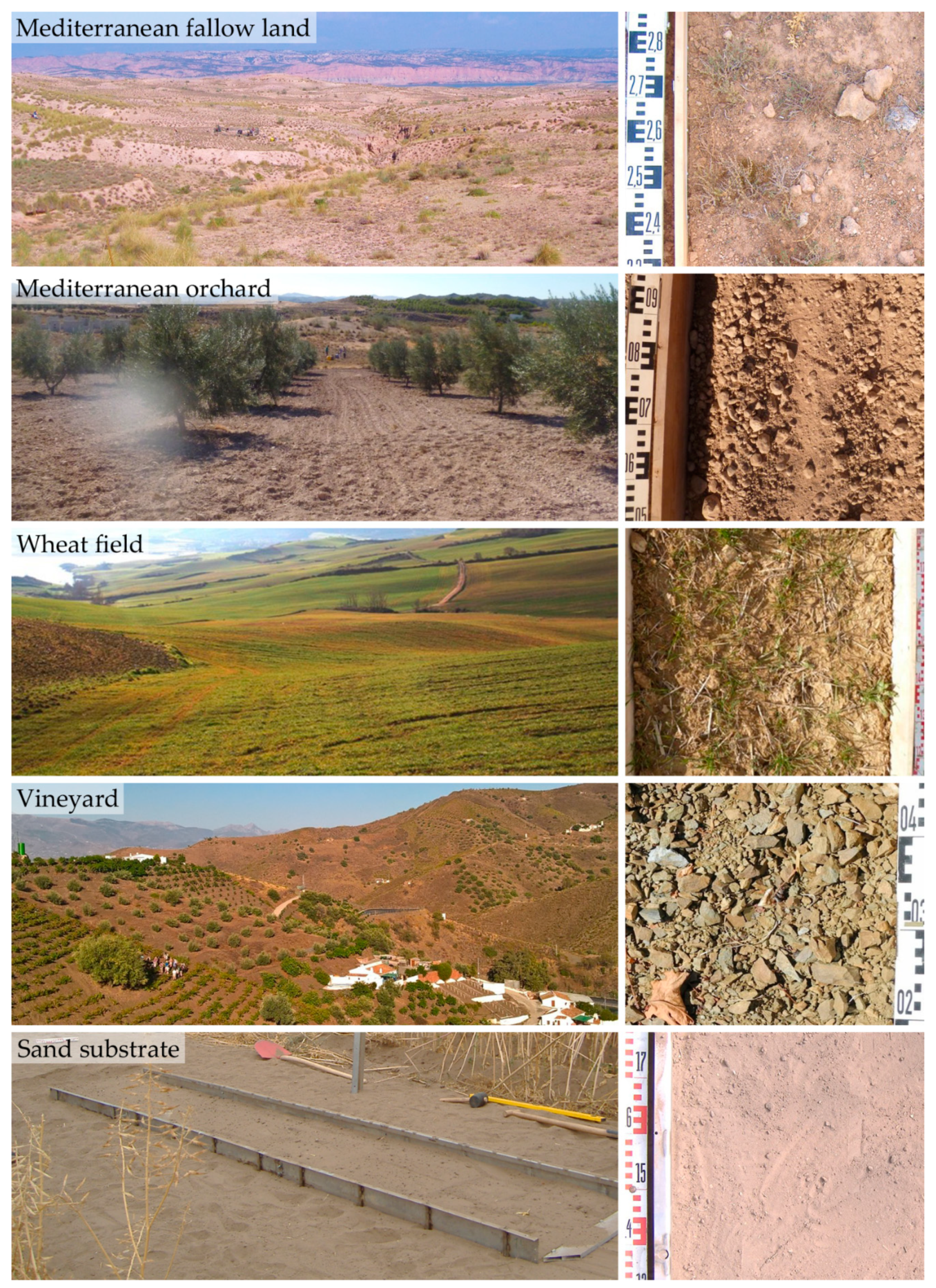
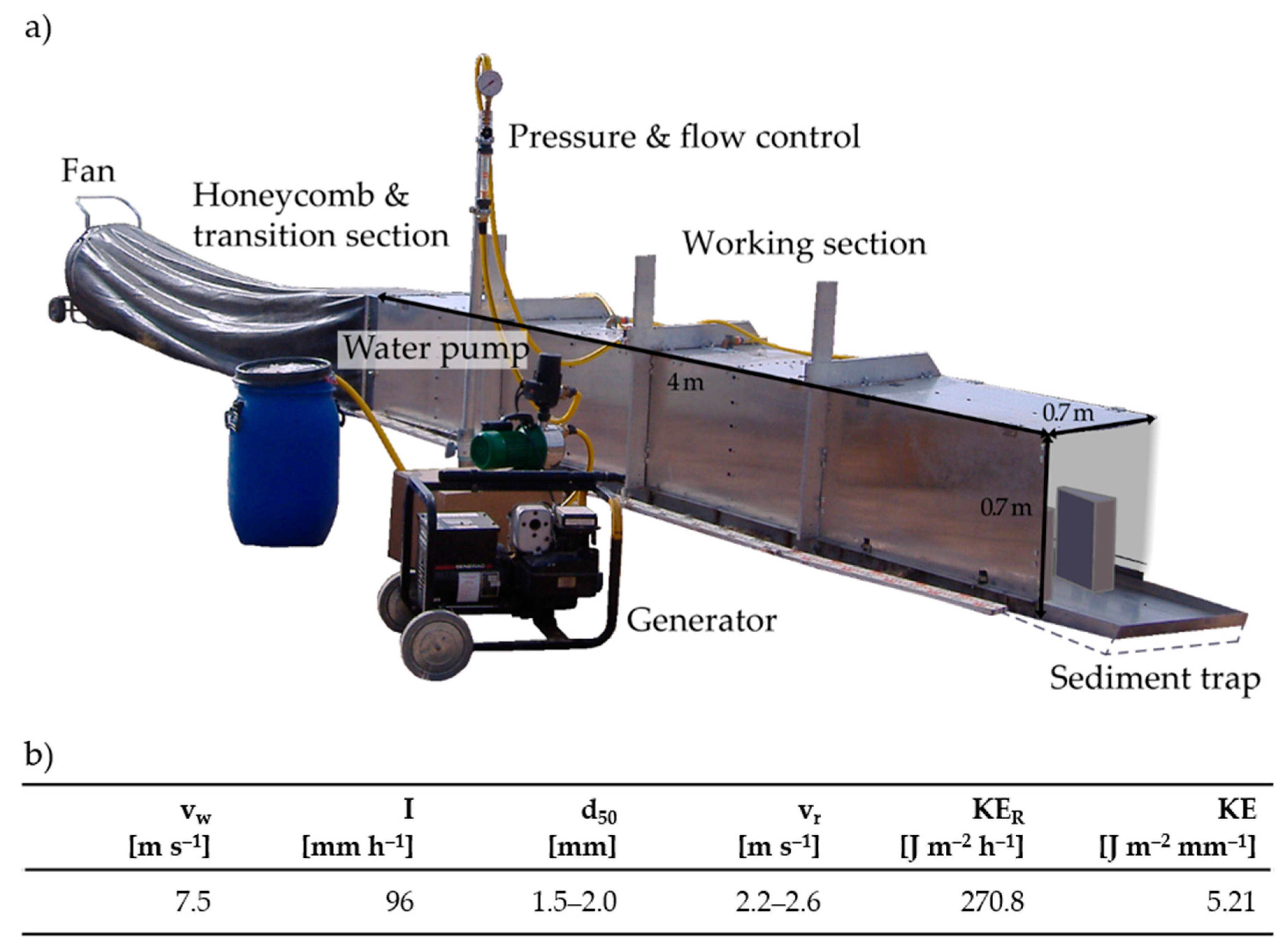
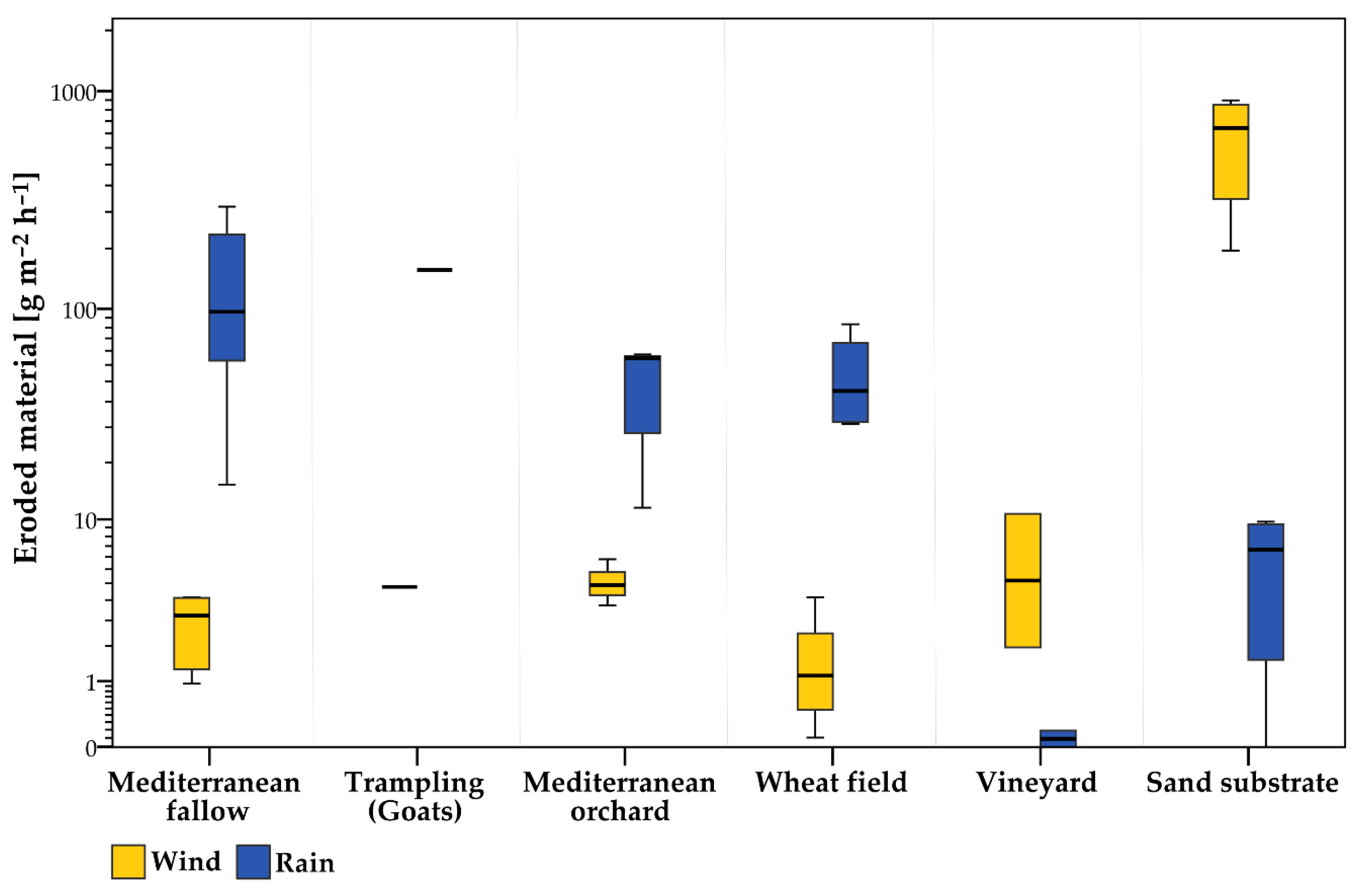
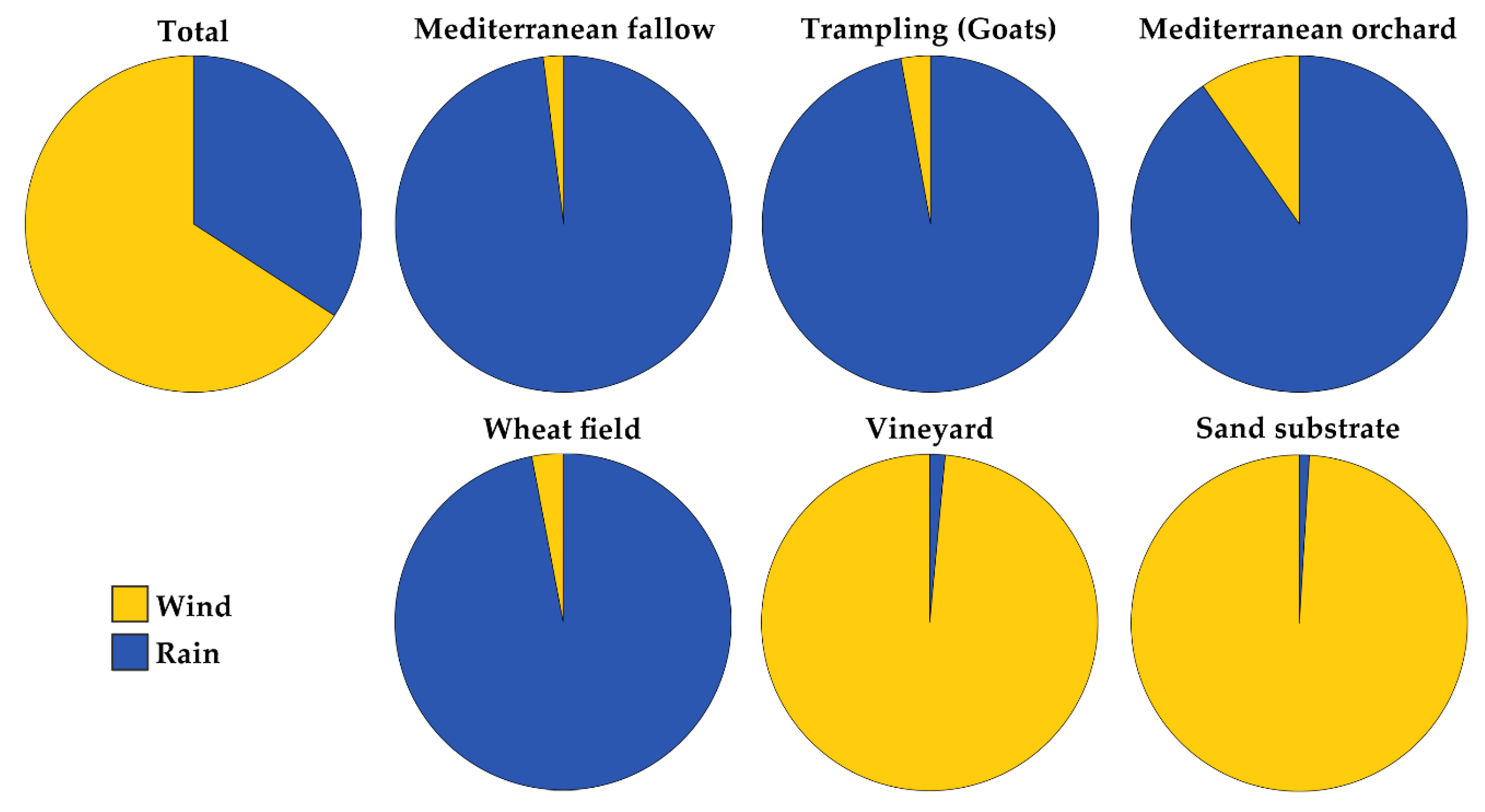
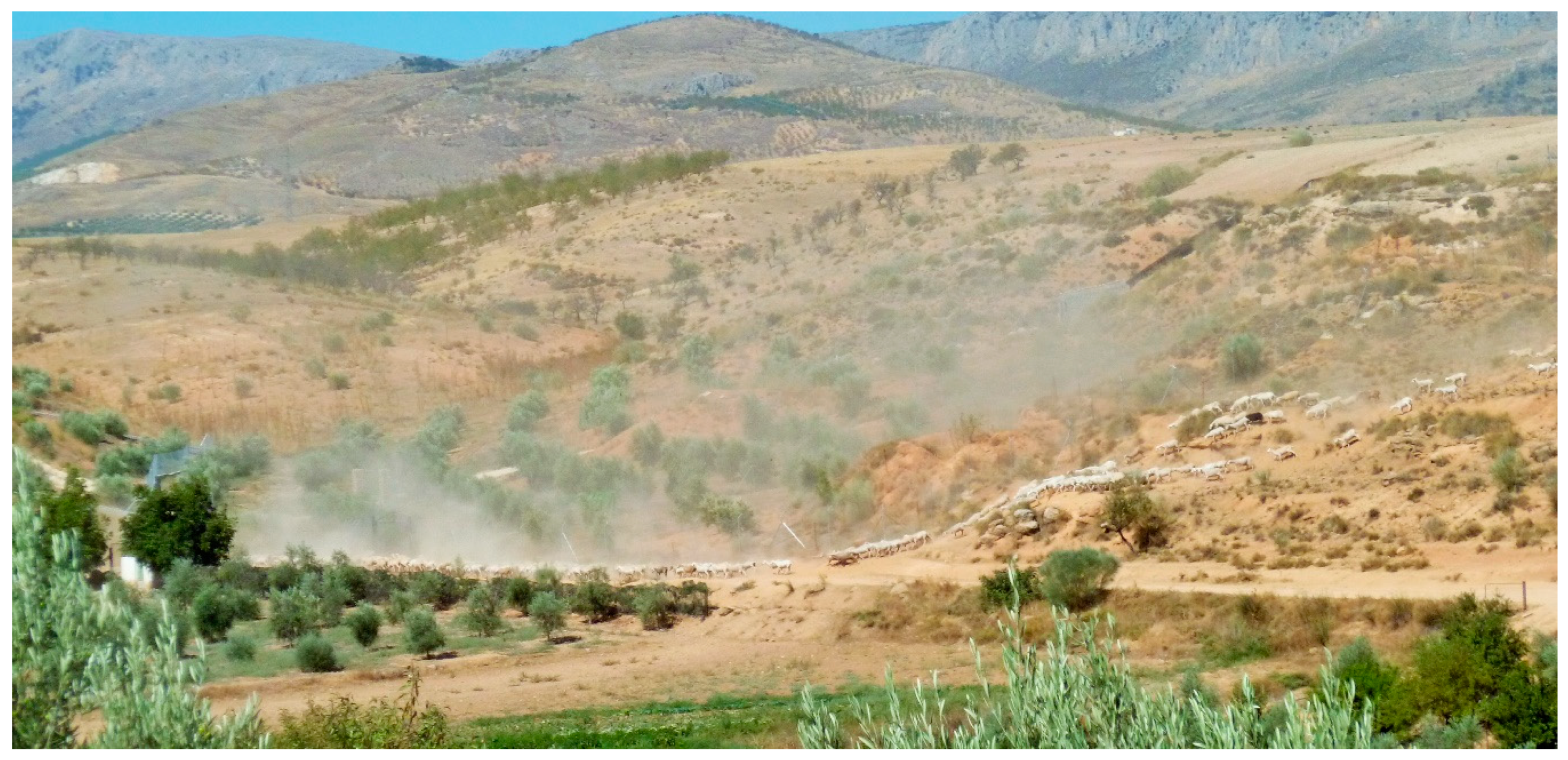
| Site | Vegetation | Crust | Substrate (Including Stones) | Slope | Texture | Roughness | Corg | Soil H2O | |
|---|---|---|---|---|---|---|---|---|---|
| [%] | |||||||||
| [%] | [%] | <2 mm | >2 mm | [°] | [Cr] | [%] | [%] | ||
| Mediterranean fallow | 15 | 20 | 0 | 65 | 11 | SiL | 5.2 | 0.4 | 4 |
| 15 | 30 | 0 | 55 | 5 | SiL | 10 | 0.7 | 4 | |
| 25 | 25 | 0 | 50 | 8 | SiL | 5.2 | 0.4 | 3 | |
| 15 | 70 | 0 | 15 | 5 | SiL | 5.2 | 0.4 | 3 | |
| 20 | 65 | 0 | 15 | 5 | SiL | 5.2 | 0.4 | 3 | |
| 15 | 20 | 0 | 65 | 7 | SL | 5.2 | 0.4 | 0.5 | |
| Trampling (goats) | 10 | 20 | 30 | 40 | 5 | SiL | 6.6 | 0.4 | 0.9 |
| Mediterranean orchard | 0 | 0 | 30 | 70 | 6 | SiL | 15 | 1.2 | 3 |
| 0 | 0 | 35 | 65 | 4 | SiL | 15 | 1.2 | 3 | |
| 0 | 0 | 20 | 80 | 8 | SiL | 10.2 | 4.1 | 0.9 | |
| Wheat field | 5 | 0 | 30 | 65 | 11 | CL | 18 | 2.5 | 47 |
| 30 | 0 | 15 | 55 | 9 | CL | 24 | 3.5 | 47 | |
| 30 | 0 | 15 | 55 | 8 | CL | 24 | 3.5 | 47 | |
| 30 | 0 | 15 | 55 | 7 | CL | 24 | 3.5 | 47 | |
| Vineyard | 0 | 0 | 5 | 95 | 7 | SiL | 17 | 3 | 0.7 |
| 0 | 0 | 5 | 95 | 8 | SiL | 17 | 3 | 0.7 | |
| Sand substrate | 0 | 0 | 100 | 0 | 1 | FS-MS | 0 | 2.9 | 1 |
| 0 | 0 | 100 | 0 | 1 | FS-MS | 0 | 2.9 | 1 | |
| 0 | 0 | 100 | 0 | 1 | FS-MS | 0 | 2.9 | 1 | |
| 0 | 0 | 100 | 0 | 1 | FS-MS | 0 | 2.9 | 1 | |
| Site | Eroded Material | Mean [g m−2 h−1] | Ratio | Ratio Mean Wind/Rain | |||
|---|---|---|---|---|---|---|---|
| [g m−2 h−1] | |||||||
| Wind | Rain | Wind | Rain | Wind | Rain | ||
| Mediterranean fallow | 0.95 | 295.47 | 2.66 | 133.9 | 0.3 | 99.7 | 2:98 |
| 1.27 | 14.89 | 7.8 | 92.2 | ||||
| 3.84 | 60.34 | 6.0 | 94.0 | ||||
| 3.7 | 155.31 | 2.4 | 97.7 | ||||
| 2.39 | 57.54 | 4.0 | 96.0 | ||||
| 3.81 | 219.86 | 1.7 | 98.3 | ||||
| Trampling (goats) | 4.41 | 151.36 | - | - | 2.8 | 97.2 | - |
| Mediterranean orchard | 4.5 | 61.48 | 4.73 | 44.00 | 6.8 | 93.2 | 10.5:89.5 |
| 3.45 | 59.08 | 5.5 | 94.5 | ||||
| 6.23 | 11.43 | 35.3 | 64.7 | ||||
| Wheat field | 0.1 | 29.05 | 1.55 | 50.29 | 0.4 | 99.6 | 3.0:97.0 |
| 1.27 | 56.95 | 2.2 | 97.8 | ||||
| 3.84 | 30.24 | 11.3 | 88.7 | ||||
| 0.98 | 84.92 | 1.1 | 98.9 | ||||
| Vineyard | 1.86 | 0 | 6.26 | 0.09 | 100.0 | 0.0 | 98.5:1.5 |
| 10.65 | 0.19 | 98.3 | 1.7 | ||||
| Sand substrate | 185.67 | 0 | 618.62 | 6.05 | 100.0 | 0.0 | 99.0:1.0 |
| 554.88 | 9.18 | 98.4 | 1.6 | ||||
| 908.19 | 9.73 | 98.9 | 1.1 | ||||
| 825.75 | 5.27 | 99.4 | 0.6 | ||||
| 6 Groups | Wind | Rain | |
|---|---|---|---|
| ChiSquare | 13.051 | 13.716 | |
| Asymptotic significance | 0.023 | 0.018 |
| Spearman’s Rho | Veg | Fine Soil | Coarse Soil and Stones | Crust | Slope | H2O % | Roughness | Corg | |
|---|---|---|---|---|---|---|---|---|---|
| Wind | CC | −0.587** | 0.503* | −0.441 | −0.236 | −0.617** | −0.655** | −0.561* | 0.166 |
| Sig. | 0.006 | 0.024 | 0.052 | 0.317 | 0.004 | 0.002 | 0.010 | 0.485 | |
| Rain | CC | 0.599** | −0.581** | −0.002 | 0.638** | 0.266 | −0.025 | 0.105 | −0.597** |
| Sig. | 0.005 | 0.007 | 0.995 | 0.002 | 0.258 | 0.916 | 0.660 | 0.005 | |
© 2019 by the authors. Licensee MDPI, Basel, Switzerland. This article is an open access article distributed under the terms and conditions of the Creative Commons Attribution (CC BY) license (http://creativecommons.org/licenses/by/4.0/).
Share and Cite
Marzen, M.; Iserloh, T.; Fister, W.; Seeger, M.; Rodrigo-Comino, J.; Ries, J.B. On-Site Water and Wind Erosion Experiments Reveal Relative Impact on Total Soil Erosion. Geosciences 2019, 9, 478. https://doi.org/10.3390/geosciences9110478
Marzen M, Iserloh T, Fister W, Seeger M, Rodrigo-Comino J, Ries JB. On-Site Water and Wind Erosion Experiments Reveal Relative Impact on Total Soil Erosion. Geosciences. 2019; 9(11):478. https://doi.org/10.3390/geosciences9110478
Chicago/Turabian StyleMarzen, Miriam, Thomas Iserloh, Wolfgang Fister, Manuel Seeger, Jesus Rodrigo-Comino, and Johannes B. Ries. 2019. "On-Site Water and Wind Erosion Experiments Reveal Relative Impact on Total Soil Erosion" Geosciences 9, no. 11: 478. https://doi.org/10.3390/geosciences9110478
APA StyleMarzen, M., Iserloh, T., Fister, W., Seeger, M., Rodrigo-Comino, J., & Ries, J. B. (2019). On-Site Water and Wind Erosion Experiments Reveal Relative Impact on Total Soil Erosion. Geosciences, 9(11), 478. https://doi.org/10.3390/geosciences9110478







